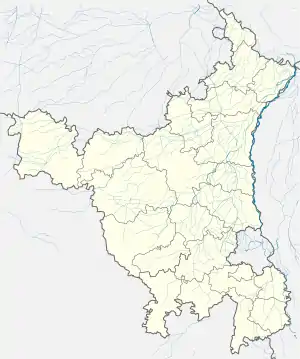Saraswati Wildlife Sanctuary
Saraswati Wildlife Sanctuary, also known as Seonsar Forest, is situated in Kaithal district of Haryana State, India. It is spread over an area of 4,452.85 hectares (11,003.2 acres).[1]
Saraswati Wildlife Sanctuary | |
|---|---|
Wildlife Sanctuary | |
 Saraswati Wildlife Sanctuary Location in Haryana, India  Saraswati Wildlife Sanctuary Saraswati Wildlife Sanctuary (India) | |
| Coordinates: 29°59′34″N 76°21′24″E | |
| Country | |
| State | Haryana |
| District | Kaithal district |
| Notified | 29 July 1988 |
| Elevation | 215 m (705 ft) |
| Time zone | UTC+5:30 (IST) |
| ISO 3166 code | IN-HR |
| Website | haryanaforest |
Kalesar National Park, Morni Hills and Saraswati Wildlife Sanctuary are respectively first, second and third largest forest in Haryana.[2]
Location
It is 10 kilometres (6.2 mi) away from Pehowa, 40 kilometres (25 mi) from Kurukshetra, 60 kilometres (37 mi) from Kaithal on the Pehowa-Cheeka-Patiala Road, 62 kilometres (39 mi) from Patiala, 66 kilometres (41 mi) from Ambala, 108 kilometres (67 mi) from Chandigarh, 150 kilometres (93 mi) from Hisar, 67 kilometres (42 mi) from Karnal, 200 kilometres (120 mi) from Delhi.[1]
It is only nearly 30 kilometres (19 mi) from Bir Gurdialpura Wildlife Sanctuary in Patiala district of Punjab.
History
Saraswati Plantation was notified as Saraswati Wildlife Sanctuary on 29 July 1988.[2]
Archaeological remains
The Tribune reported on 9 April 2016 that Mahant and members of a dera of Nath yogis in the sanctuary found the ancient rectangular bricks from a 15 feet deep structure after an old banyan tree was uprooted.[3] According to Rajendra Singh Rana, curator of Kurukshetra’s Srikrishna Museum, prima facie these bricks and structure appears to be older than 1500 years old as square bricks are associated with 1,500 years old Gupta period (320 CE to 550 CE) and these bricks are likely to be even older from the Kushan (30 CE to 375 CE) period as the Sarasvati river use to flow here.[3]
There is also a 40 years old Water well made of small lakhauri bricks associated with the Mughal empire era.[3]
See also
- List of National Parks & Wildlife Sanctuaries of Haryana, India
- Haryana Tourism
- List of Monuments of National Importance in Haryana
- List of State Protected Monuments in Haryana
- List of Indus Valley Civilization sites in Haryana, Punjab, Rajasthan, Gujarat, India & Pakistan*
- List of national parks of India
- Wildlife sanctuaries of India
- Kalesar National Park, 15 km from Yamunanagar, location map
- Sultanpur National Park, 25 km from Gurgaon on Chhachhrauli road, location map
- Bir Shikargah Wildlife Sanctuary, Pinjore

